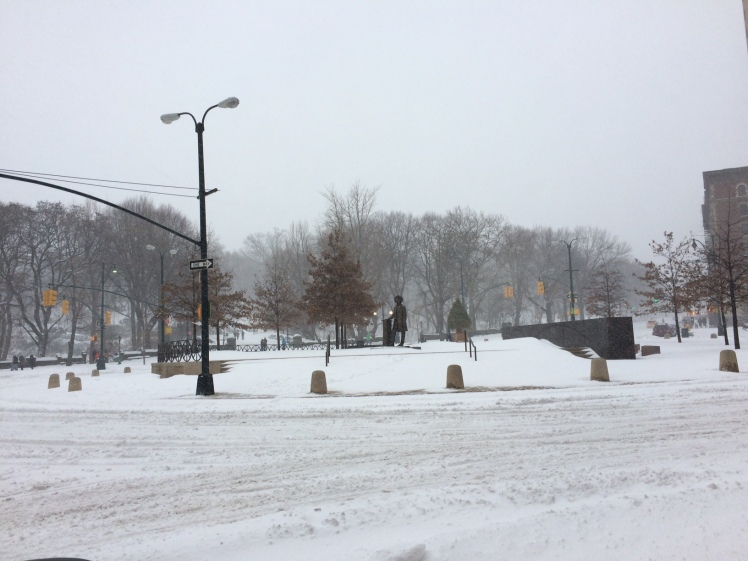
It was one week ago that Winter Storm Jonas came to NYC. Two notable forbiddances have occurred in this seven-day stretch: on the roads, there was a temporary motor transit ban, and in Brooklyn, a resident who constructed an igloo on his property and tried to rent it out on Airbnb had his listing taken down within several hours.

After the precipitation had settled and things were more or less back to normal, I took the chance to travel north to a wooded area where I could try snowshoeing for the first time.

While there were some traces of human impact along the trails of Anthony’s Nose, on Monday, we had the whole hike to ourselves.

The lack of leaves on the trees on both sides of the Hudson made views of the snowy Bear Mountain grounds much clearer.

After a taste of nature it was time to remove the snowshoes and return to civilization, the designated outpost being Peekskill, NY. The town itself is as friendly as the sign suggests (but not as creepy as its overall appearance suggests).
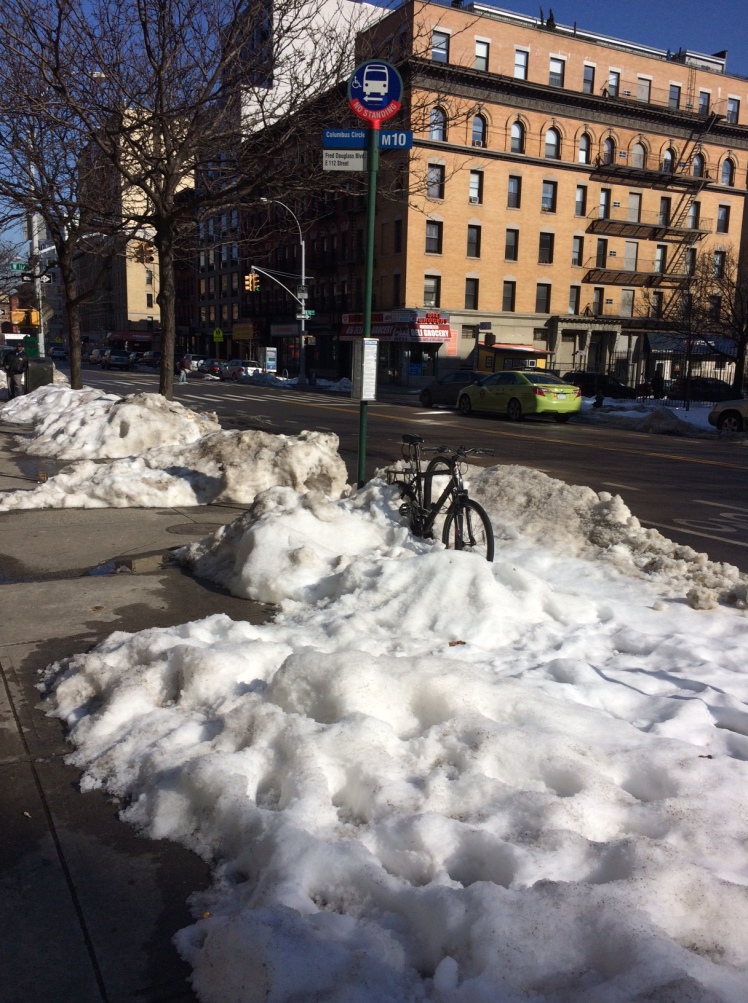
Back in NYC, the snow has been gradually melting.
 Some mountains have amassed on street sides–some prettier than others.
Some mountains have amassed on street sides–some prettier than others.
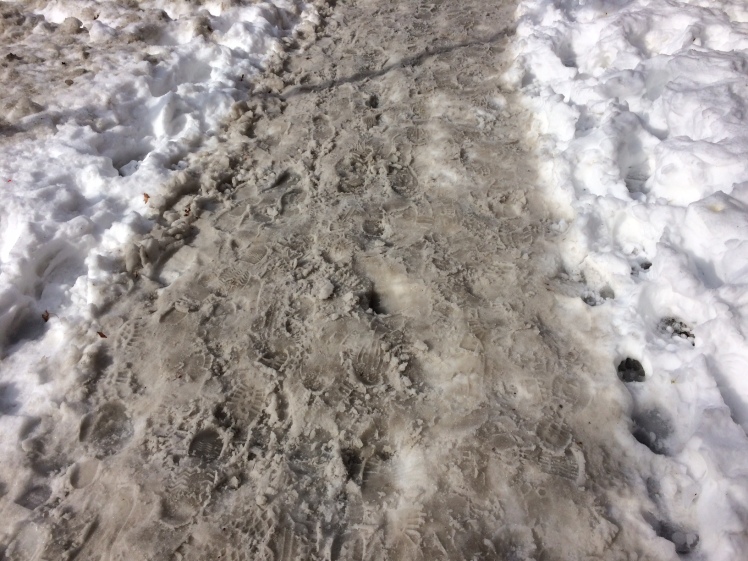
Snowshoes aren’t needed, but still, proper footwear is required for urban snow navigation.
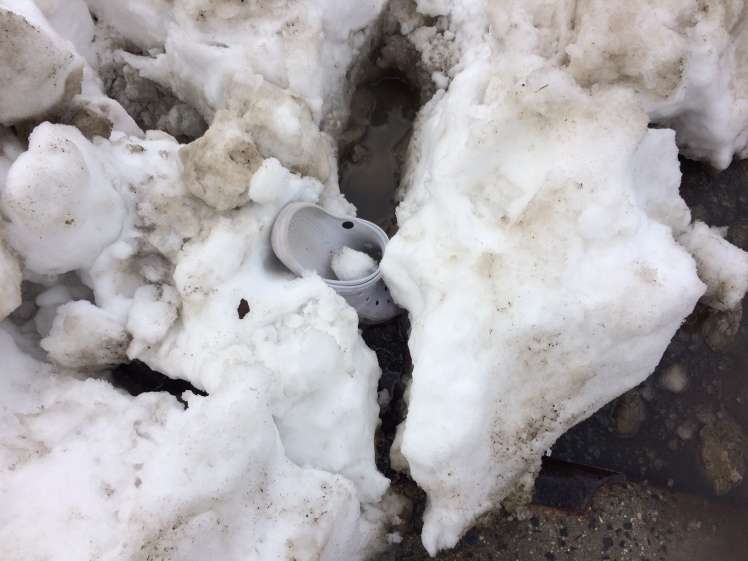
Crocs are not recommended.
Puerto Rico: Analog Film and Big Bamboo
I discovered on my fifth morning in Puerto Rico that my means of digitally documenting or navigating the island were null. My smart phone had died. I consequently acquired a pair of noble instruments on which I could visually capture and travel to the remainder of places I wanted to visit: a disposable camera and a paper map.
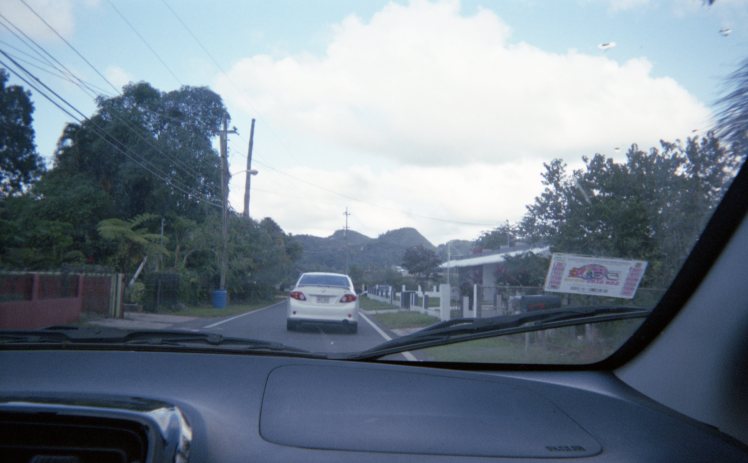
Reading the roads off of what’s printed on a basic tourist map makes journeying through the forests in an itty-bitty car all the more intricate—and, perhaps, more intimate. Tracing the trajectories this way came challenging at times, especially when forks lacked signs or surprise signs popped up to mark unmapped roads. After dissuading ourselves from wondering why speed limits were posted in miles while distance markers measured kilometers, noting the numbers printed on the latter series of signs proved fruitful for figuring out which roads and directions we were driving.
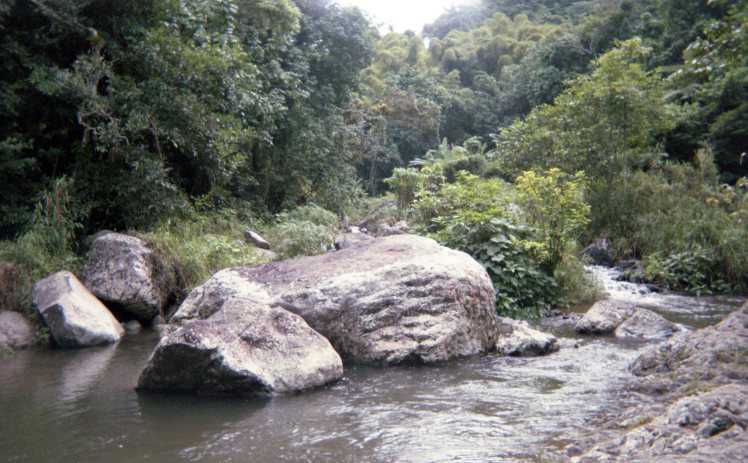
Several stars speckled the map’s roadsides to indicate where drivers could take a break. As passenger and navigator, I took note of a few starred waterfalls and minor water bodies to go see.

We also parked outside a the entrance of a popular pedestrian path—that appeared to have been converted from a former vehicular route—for a brief hike.

Crop-wise, banana trees and coffee plants thrived throughout Puerto Rico’s central, hilly terrain. Out in the more remote, less inhabited stretches, the wild flora’s extensive branches grew gangly and would whip into our little car’s windshield as we crept on through.
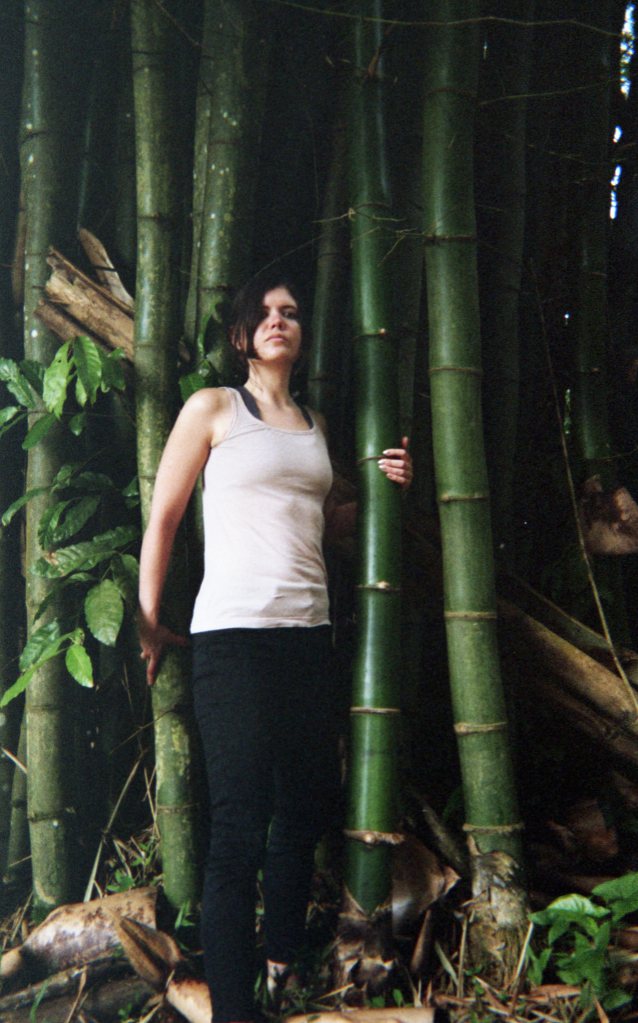
Giant bamboo stalks towered above many roads, and these plants feel even more mammoth when up close and personal.

Horseback riding was the most common means of transportation for several parts of Puerto Rico. It was necessary to pause for and pass the horses as they clomped down the same paved paths.
The farthest north and west we drove was Aguadilla, a city that’s not so visited for being a city but more as a sea and surf spot. Admittedly, some of the surfers who had come to the place specifically for their favorite sport confessed that the waves were too aggressive for their taste. Since I don’t surf, I was keener on observing what the coastal scenery had to offer.

One such site was what remained from the façade of a former seaside lighthouse that was flooded last century.
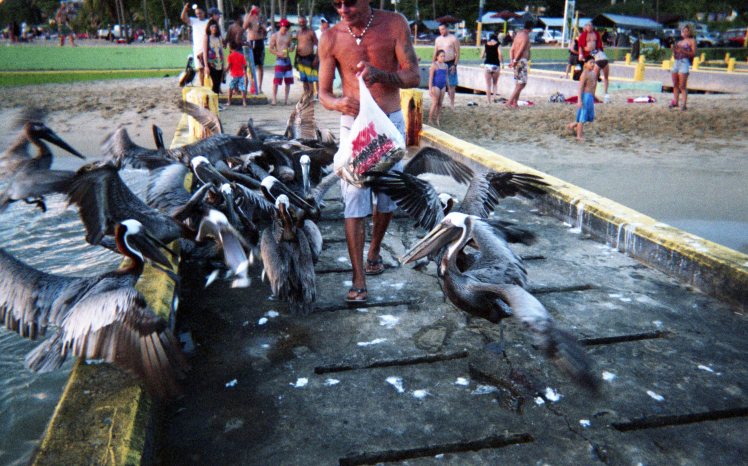
Crash Boat Beach is another one of Aguadilla’s leisurely coastal spots. Swimmers jump off of the piers jutting out into the saltwater, and onshore, seagulls and pelicans flock to a Pelican Man, a figure who feeds them fish from his plastic bag.
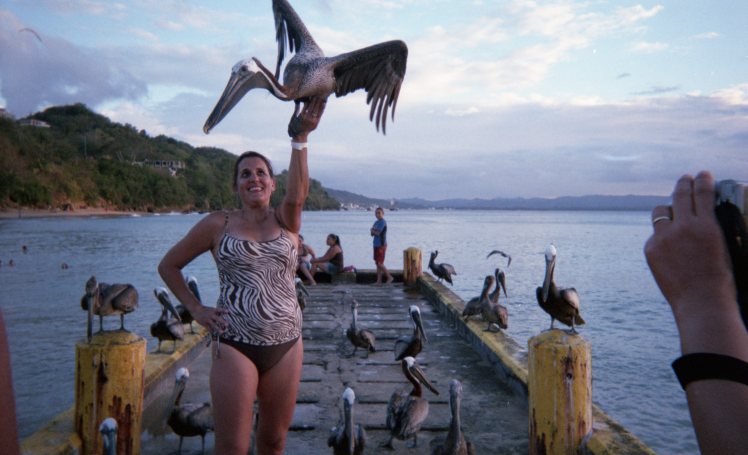
The Pelican Man has trained several of his feathered friends to perch themselves on human arms for photo ops. Though I was at first considering extending a limb for this rare inter-species opportunity, I was immediately discouraged when I saw how bird vomited fishy bits when it was hoisted.
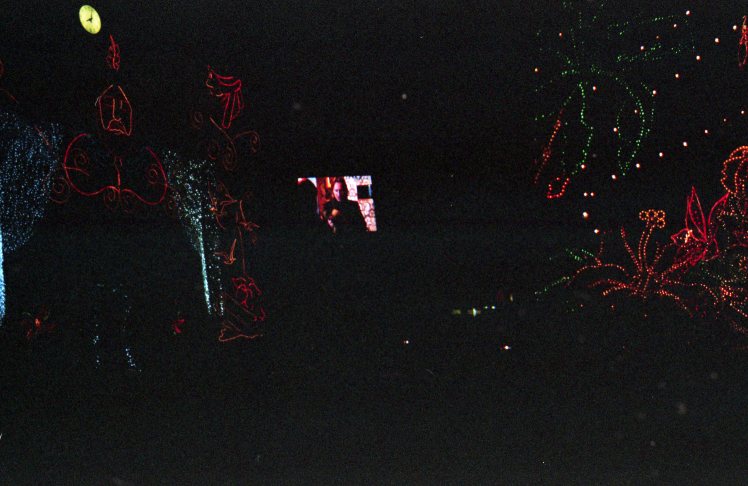
An installment of dazzling city lights illuminated Aguadilla’s downtown area to celebrate the holiday spirt.

Since it’s been years since I’d used a disposable camera, I was reminded of the reality of its finite nature, offering a roll of 27 shots of which I should choose wisely. Upon developing and scanning the film, I realized that trying to snap a shot of Puerto Rico’s biggest stalagmite formation in the depths of Rio Camuy Cave was unwise. It was, however, a decent idea to try for an image of the lushly developed limestone ring that framed the sky view.

Although all of my phone’s fotos de gatos prior to my fifth morning had disappeared, I didn’t let that loss discourage me from enjoying Puerto Rico’s diverse feline population, one that’s composed of demographics like the lazy island bums around Culebra’s beach kiosks and peppy city mewers nurtured by San Juan’s Save a Gato sanctuary. During the hottest parts of the daytime, Puerto Rican cats can be seen lazing in whatever shady spot they deem suitable for napping, whether it is against the base of a big monument or beneath the belly of a parked vehicle.
Flatness and Hotness
A pair of environmental consistencies remained constant throughout a recent trip to South Florida: flatness and hotness.

In the realm of the region’s civilized constructions, many cultural components of the Ft Lauderdale metro area seemed consistent, from my conditioned recognition of American consumer big-box chains (albeit built in pastel editions) to the general of pace I’d remembered of the place. Though, having resided in Northerly regions virtually my entire life, the presence of palm trees always comes as a novelty.

The calming palms weren’t the only trees that impressed me by their nature. The potted bonsai trees atop outdoor plinths at the Morikami Museum and Japanese Garden did not disappoint my expectation to stand in awe at such small-scaled specimens of organisms that are often over-towering when not maintained in miniature form. Perhaps the density enhances the inherent magnificence.

The path looping along the Morikami Museum’s lush grounds offered educational tidbits about Japanese garden models–for instance, the embracing of more nature-inspired aesthetics, as seen in the Modern Romantic Garden, as opposed to installments that fell more in accordance to traditional philosophies or rendered abstraction, like certain rock gardens.

Beyond learning what botanic species and aesthetic concepts could be successfully imported from Japanese garden culture to exist in the Floridian setting, the Morikami Museum offered the chance to see what types of reptiles and amphibians could thrive within a contained ecology as such.

Colossal koi and whiskery catfish slid throughout the water of the pond’s slimy shoal, while gliding turtles would occasionally prick their pointy snouts through the top line of murky aquatic limits.

On the land-side, four-legged, cold-blooded creatures scurried stones, soil, and brush before locating the perfect peak from which to perch.

The state’s flat surface was replete with water bodies, big and small, against horizons, a scene that was seen by standing along of circumference of the freshwater lake that the Morikami gardens looped around.

Chlorinated blue waters shimmered, surprisingly brilliantly, under the bright blue skies in a more manufactured form: a chain hotel’s onsite swimming pool back-dropped by a multistory car dealership.

What naturally came as less of a surprise was the way the Atlantic offered a saltier, splashier expanse of azure stretching far beyond the coastal limits of the locality’s (and country’s) continental bounds.
Driving, to Walk and See Michigan
Seeing the disparate sites throughout the Motor City is an adventure that requires automobile access. Appropriately enough, curious drivers who get the opportunity to site-see around Detroit can pay homage to the very spot where the model machine that made the automobile accessible to the masses was first manufactured: the Ford Piquette Avenue Plant.
The invention of the Model T was undoubtedly innovative during the early 20th Century; the classic car remains emblematic today. However, today, the building of the Ford Piquette Avenue Plant serves as a cultural relic, its historical significance explained in texts posted upon outdoor placards. The former factory is now in the midst of a vast, desolate cityscape that’s comprised of the bustling factories and inhabited houses of yesteryear. Presently, forces of gravity and decay have noticeably transformed the forlorn two-story homes while the external remnants of a giant, boxy industrial structure have become an enormous canvas for spray paint.
Some unfavorably liken the admiration of the abandoned buildings aesthetic as “ruin porn.” Voyeurs ogle over the cave-ins and collapses of formerly functioning architecture, fetishizing over the imagery of shattered glass windows or little weeds that pop out of the gritty cracks between wooden panes. Perhaps I’m myself guilty of having a peeled paint or cracked pavement fetish while scaling these exposed, vulnerable structures.
Taking a casual drive downtown isn’t something you’ll commonly hear of here in New York City. To me, the thought of heading downtown is synonymous with riding the subway. In Detroit, however, the idea of driving downtown did not sound strange at all.
We drove downtown indeed. We parallel parked on the city street to then stroll to the Renaissance Center, the ensemble of seven slick skyscrapers. We dubbed them the “Robocop towers” in reference to the film’s scenes where greedy executive leaders or flakey marketing pitchsters would schematically conjure their controlling intentions or devise outlandish outreach schemes while looking down over Detroit.
Ascending to the top floor of landmark skyscrapers is never something I do in New York (unless you count a kindergarten day-trip to the top of the World Trade Center circa late 1991). Nevertheless, I rode the elevator from the 3rd to the 72nd floor of the Renaissance Center to leisurely look out over the Detroit area.
There, the most immediate sites visible through the carousel of glass windows were Belle Isle sitting on the river, Canada stretching across the river, and the nearby sports bowl stadium where the Tigers play ball. On a greater scale, gauging the elevated panoramic scenery proved how extensively and consistently flat the landscape’s topography really was.
A more immediate component of the tower’s view, down on the 71st story, was the sets of seating arrangements and shapes that shadows formed.
The next destination was a marvel of modern ruin, the Michigan Central Train Station. Off we drove from downtown to the defunct terminal where a train has not passed in over 27 years.
Sure, I’d seen numerous depictions of the Michigan Central Train Station, in numerous photos where the shambled state of the structure was back dropped by the downtown Detroit skyline. I still wanted to see the building my very own eyes and document it with my personal devices.
We parked in front of the fenced-off former station and studied its cracked building blocks. I strolled into a nearby small garden of what looked like wheat to get a wider perspective. Cicadas buzzed eerily as the garden’s stalks whipped and rolled with the breeze. I paced through the path of gaps that divided the patches, but failed, after several attempts, to capture a quality shot.
That night, we partook in a quintessential American car-centric entertainment activity, in driving to the suburban city Dearborn, Michigan, and parking in drive-in theater to watch a mainstream movie.
Since Michigan is a big place that of course means there is more to drive through than just the Detroit metro area. So, we ventured off to Grand Rapids, the state’s second biggest city, then to Holland, a quaint, semi-touristic village lined with candy stores and other gift shops. We then traveled as far west as we could possibly reach in the bounds of the state’s Lower Peninsula. We parked. We walked down a dune, strolled across the beach stretch, sat upon the sand, and then swam into to the great Lake Michigan.
While retreating back to the Detroit area, we stopped in Ann Arbor for lunch, a Michigan city I was admittedly ignorant of except for knowing that’s where Iggy Pop was from. Ann Arbor turned out a pleasant college town that reminded me of several I’d seen (like Eugene and Ithaca) with similar commercial establishments (like local health food stores and book shops).
My favorite part of Ann Arbor wasn’t the eating or shopping, but the tubing and boating. I did neither of these activities, but partook in wading the shallow river while more equipped visitors floated by in tubes or boats.
Naturally, the car was necessary throughout the trip, but the best and most unexpected parts of it took place on foot, after parking.
Detroit and Independence Day
I’d heard a lot about the place but never been. As such, this year’s July 4th weekend ended up being the perfect time to finally go into and around Detroit.
First thing’s first on a national holiday weekend, and that’s entertainment. At mid-day on the Friday before Independence Day, the best entertainment around Farmington Hills, Michigan, is found at Marvin’s Marvelous Mechanical Museum. Tucked in the back part of a suburban stripmall, this hokey enclave is stocked with all sorts of coin-operated arcade games, mechanical puppet ensembles, and animatronic fortune-telling figures that have no reservations calling you dumb (or even a schmuck). Naturally, the kistch Marvin has collected and curated is superb.
Belle Isle, the recreational river island park between the US and Canada, was the next destination for Independence Day eve. The onsite Conservatory proved largely green and leafy within its Tropical House–but also detailed in a floral manner, with orchids, and with a fruity touch, with pineapples.
Appropriately, the Fernery section was replete with ferns, while the Cactus House was more arid in atmosphere and (often) spiky on its plants’ surfaces.
Because the Detroit Institute of Arts is currently featuring Frida Kahlo’s art, the Conservatory placed placards by select flora to indicate which plants were native to Mexico.
Belle Isle proved an easy-going place to tour. While there, we also visited its aquarium and nature zoo, then walked down a long dock and passed by a small beach. Additionally, the island was a pleasant vantage point to observe the urban skyscrapers.
On the actual day of July 4th, we decided that Greenfield Village, an outdoor museum complex full of historical structures (many of which were collected by Henry Ford), was the best spot to pay homage to American heritage. Greenville Village hosts attractions like the house where Wright brothers grew up and the bicycle shop where they worked.
Hailing from 17th Century Cape Cod, Farris Mill, what is said to be America’s oldest windmill, now stands mightily at Greenfield Village.
The upper level of Thomas Edison’s Menlo Park laboratory offers quite the cornucopia of jarred chemicals. Except apparently a number of scientific materials were confiscated for being unsafe several decades ago, so a decent deal of empty glass bottles remain on the shelves. The days of freely tinkering with mercury are long gone.
Such was the case in Greenfield Village’s tintype studio. Tintypes were a photographic medium that were popular prior to film, and mercury was used to develop images. While the onsite darkroom is no longer functional, present-day visitors are still welcome to sit in the spot where sitters of days past sat, sunned by the ethereal rays of natural lights, to have their digital portraits instantly taken.
The night of July 4th we spent cruising through town, eventually parking the car and walking to a lawn that surrounded a suburban shopping plaza’s parking lot in time to see the fireworks show. Traditions are traditions, and it’s comforting to learn that one like colorful explosives in the night sky is preserved across the different states.
For the 5th, we visited the city’s Midtown district to go to the Detroit Institute of Arts. While we didn’t make the Frida Kahlo/Diego Rivera special show due to long waiting times and frightful lines, we did check out the latter artist’s permanent murals that he painted around the Rivera Court.
The settings were crowded, but museum patrons could still hone in on the infinite details that comprised these massive works, be it managers’ greedy facial expressions or fiery backdrops of industrial production.
From cruising across the multi-lane highway roads to walking through the preserved domestic settings of domestic inventors to sampling bits of of foreign culture, the Detroit metro area ended up being a region that was full of educational opportunities and American representation.
Minor Water Bodies
At times, ordinary household objects are taken out of their context, where they look deliberately removed. For instance, a small coffee pot I purchased at a Halal supermarket in Bay Ridge looks entirely different along the perimeter of a campfire bed. Perhaps the novelty of the vessel’s removed presentation makes it look even more attractive than when placed atop a domestic stove top.
Alas, a natural pond looks different from whatever micro pond a faucet may create in a kitchen.
The first use this tent received was to keep us high and dry in the Catskill Mountains, in an area close to Livingston Manor, NY.
Water flowed around the field.
Removed from distractions of society, aquatic motion is always a go-to for nature’s entertainment.
Though, when more water fell from the sky, that’s a different story.
Out of the woods we fled, another water universe we found: a fish hatchery. It might be hard to see in this photo, but the image placed on the truck was meant to promote tours by writing “Fish are Photogenic”. I wonder what the fish would think.
Off to another camping spot, we purchased a gallon of water to avoid the iodine process the adjacent stream would require.
Though the stream’s water appeared to offer its own feedings for local life forms.
Costa Rica: Town, Cloud Forest and Volcano
The small town of Bagaces, Costa Rica, is a pleasantly relaxed place.
However, try not to get stuck there on Good Friday. It’s a major holiday, making the buses few and far between. Scant travel options was something we discovered that very day, by waiting on at the edge of town for several hours in the heat. I did not take a photo there, as it was nothing to see, but we got to know a street-side bus stop quite well. Finally, we crossed the street and hailed down a bus going the opposite direction, just to get out of Bagaces. The driver overcharged us because he could see our desperation and we ended up in the city of Liberia.
Upon entrance to the bus terminal in Liberia, we were hot, sweaty, disgruntled, and wanted to get out. A bus was leaving soon enough for Playas del Cocos, a destination of which we had no knowledge, but decided to take a chance.
And it wasn’t so bad.
We met a man from Montreal who relocated to Cocos and ran a Lebanese food stand in town. He instructed us to walk along the rock formations to a secluded white-sand area. There we went very early in the morning.
Though it was an enjoyable, spontaneous time, Playas los Cocos is not somewhere I’d recommend ending up on Good Friday, either. It’s apparently a huge vacation spot for people who live in Costa Rica, which is fun and festive, but accommodations are scarce and prices are inflated.
At least the place we stayed had a cat, Cleopatra.
The place we stayed at in Monteverde the next night was more worth it–given this was the view outside the balcony. At night, I even noticed an armadillo scrambling around the ground.
Of course it’s not about just staying at the that’s not the best open view of the trees.
Naturally, climbing up into the hills to watch the sunset is more worthwhile than hanging at the guest house.
Some of the establishments, like this art camp, display intriguing little structures that play on capabilities of human creativity with nature. Like this gazebo, which resembles trees, and is made out of trees.
Even better, of course, are trees that haven’t been re-appropriated to show trees. At the Tropical Cloud Forest, life is abundant, but sometimes difficult to notice in the lush density of flora.
Look up, and it’s the same tangled case.
Note: watch out for Spider Monkeys atop. They tend to throw down strange items when they are eating.
Or, for falling trees.
At a mountain in the clouds, elevated water vapor must go through a physical reaction, thus fall, at some point.
After Monteverde, we journeyed by van to boat to van to La Fortuna.
Finally in La Fortuna, several journeys presented themselves within, for instance, upwards on a volcano.
Some of the mud was rather clay-like.
This part was through pasture lands lined by flowery bushes, with cows grazing and butterflies flapping throughout. Occasionally, we’d pause by a guided tour group observing intriguing cases of ecological niche phenomena to listen in on some information–such as ants carrying pieces of leaves or flowers to create fungal concoctions for their colonies’ functions.
That open part was steep, but the real challenge came up the muddy, more root-covered area toward the top.
Costa Rica: City, Felines and Dryness
Starting in San Jose, Costa Rica, the nicest part I noticed during the brief overnight-to-morning stay was the view outside the downtown hotel balcony.
Hence, the only pictures there.
After snapping the visual evidence above, it was time to scramble around to locate a bus-through mazes of different companies’ terminals-and journey elsewhere. Specifically, to Canas.
Being in Costa Rica, first thing’s first: Big Cats.
At Las Pumas, the staff cares for assorted rescue animals. This jaguarundi, they wrote, had deformed legs so she could not live in the wild. Her friend was a three-legged Jaguarundi who got that way because she got caught in a trap trying to hunt chickens.
Ronia, the margay (who is a bit hard to see in this image) lives at Las Pumas because some people tried to keep her as a pet. Not an appropriate domestic cat, but so small and cute you could see why someone would attempt at such. She jumps very high distances like it’s nothing.
Next stop was Palo Verde.
It was described as a tropical dry forest with lots of migratory birds. Tropical dry forest, yes: hot, arid, and replete with flora. The anticipated abundance of avian fauna wasn’t as present as expected, though.
Many of these friendly mammals were present throughout the forest and dwelling area. We also saw some monkeys here and there; no felidae were spotted, but since we’d visited Las Pumas before, my desire was appeased.
Ascending the hot, dry, rocky cliffs could get quite brutal, but vast views made the journey worthwhile.
Plus, flatter, lower areas, offered opportunities to refreshingly dry off in the wind.
Snowy Walks
![IMG_1073[1]](http://tanyas618.files.wordpress.com/2014/02/img_10731.jpg?w=300) Residual snow is pleasant up the hills, on a leisurely Sunday.
Residual snow is pleasant up the hills, on a leisurely Sunday.
![IMG_1076[1]](http://tanyas618.files.wordpress.com/2014/02/img_10761.jpg?w=300) Especially when the air is well above freezing, while the snow has yet to melt.
Especially when the air is well above freezing, while the snow has yet to melt.
![IMG_1077[1]](http://tanyas618.files.wordpress.com/2014/02/img_10771.jpg?w=300) So you can stroll around to enjoy the scenery up close…
So you can stroll around to enjoy the scenery up close…
…and in the distance.
However, incoming snow can be stressful, in the city, on a routine Monday.
![IMG_1081[1]](http://tanyas618.files.wordpress.com/2014/02/img_10811.jpg?w=300) Especially when modes of transportation are affected.
Especially when modes of transportation are affected.
![IMG_1091[1]](http://tanyas618.files.wordpress.com/2014/02/img_10911.jpg?w=300) Something about walking around in the grey slush doesn’t feel quite so serene like hiking through white snow in the woods.
Something about walking around in the grey slush doesn’t feel quite so serene like hiking through white snow in the woods.
![IMG_1093[1]](http://tanyas618.files.wordpress.com/2014/02/img_10931.jpg?w=300) At least some scenery is pleasing in the distance, when you can look up from the dingy puddles and piles that accumulate by the curbs.
At least some scenery is pleasing in the distance, when you can look up from the dingy puddles and piles that accumulate by the curbs.
Prospect Park Zoo & Lakes
The main reason I visited the Prospect Park Zoo on my day off was to see the Pallas Cat, a species which hails from Central Asia. Cute, fluffy and small, its accompanying descriptions had to reinforce the fact that the breed is far from a domestic cat, and definitely a wild one — but I still admired the seemingly pensive feline, and its wise stares, nonetheless.
![IMG_1051[1]](http://tanyas618.files.wordpress.com/2014/01/img_10511.jpg?w=300) I made some new friends, though, with the more domesticated creatures. Although I think this one’s love is conditional, based on the presence of goat feed in my hand.
I made some new friends, though, with the more domesticated creatures. Although I think this one’s love is conditional, based on the presence of goat feed in my hand.
![IMG_1042[1]](http://tanyas618.files.wordpress.com/2014/01/img_10421.jpg?w=300) Not all attempts at friendships worked.
Not all attempts at friendships worked.
![IMG_1040[1]](http://tanyas618.files.wordpress.com/2014/01/img_10401.jpg?w=300) But you can still admire a peacock’s color scheme regardless of your personal encounter.
But you can still admire a peacock’s color scheme regardless of your personal encounter.
![IMG_1050[1]](http://tanyas618.files.wordpress.com/2014/01/img_10501.jpg?w=300) This one is a type of pigeon that dwells in the tropics. Perhaps they placed him there to provide viewers perspective on the common urban pigeons we see here.
This one is a type of pigeon that dwells in the tropics. Perhaps they placed him there to provide viewers perspective on the common urban pigeons we see here.
![IMG_1053[1]](http://tanyas618.files.wordpress.com/2014/01/img_10531.jpg?w=300) Out of the zoo and near the Audubon Center, branches made interesting formations in the water.
Out of the zoo and near the Audubon Center, branches made interesting formations in the water.
![IMG_1057[1]](http://tanyas618.files.wordpress.com/2014/01/img_10571.jpg?w=300) If the melting ice and cold weather weren’t telling enough, park keepers make sure to float buoys in the water to tell you not to enter the wintry lake.
If the melting ice and cold weather weren’t telling enough, park keepers make sure to float buoys in the water to tell you not to enter the wintry lake.
![IMG_1055[1]](http://tanyas618.files.wordpress.com/2014/01/img_10551.jpg?w=300) At least pedestrian bridges were erected in the 1800’s to solve that problem.
At least pedestrian bridges were erected in the 1800’s to solve that problem.

























![IMG_1507[1]](http://tanyas618.files.wordpress.com/2014/08/img_15071.jpg?w=300)
![IMG_1509[1]](http://tanyas618.files.wordpress.com/2014/08/img_15091.jpg?w=300)
![IMG_1511[1]](http://tanyas618.files.wordpress.com/2014/08/img_15111.jpg?w=300)
![IMG_1512[1]](http://tanyas618.files.wordpress.com/2014/08/img_15121.jpg?w=300)
![IMG_1517[1]](http://tanyas618.files.wordpress.com/2014/08/img_15171.jpg?w=300)
![IMG_1524[1]](http://tanyas618.files.wordpress.com/2014/08/img_15241.jpg?w=300)
![IMG_1528[1]](http://tanyas618.files.wordpress.com/2014/08/img_15281.jpg?w=300)
![IMG_1530[1]](http://tanyas618.files.wordpress.com/2014/08/img_15301.jpg?w=300)
![IMG_1532[1]](http://tanyas618.files.wordpress.com/2014/08/img_15321.jpg?w=300)
![IMG_1534[1]](http://tanyas618.files.wordpress.com/2014/08/img_15341.jpg?w=300)


![IMG_1188[1]](http://tanyas618.files.wordpress.com/2014/04/img_11881.jpg?w=300)
![IMG_1195[1]](http://tanyas618.files.wordpress.com/2014/04/img_11951.jpg?w=300)
![IMG_1199[1]](http://tanyas618.files.wordpress.com/2014/04/img_11991.jpg?w=300)
![IMG_1201[1]](http://tanyas618.files.wordpress.com/2014/04/img_12011.jpg?w=224)
![IMG_1205[1]](http://tanyas618.files.wordpress.com/2014/04/img_12051.jpg?w=300)
![IMG_1206[1]](http://tanyas618.files.wordpress.com/2014/04/img_12061.jpg?w=300)
![IMG_1208[1]](http://tanyas618.files.wordpress.com/2014/04/img_12081.jpg?w=300)
![IMG_1209[1]](http://tanyas618.files.wordpress.com/2014/04/img_12091.jpg?w=300)
![IMG_1211[1]](http://tanyas618.files.wordpress.com/2014/05/img_12111.jpg?w=300)
![IMG_1218[1]](http://tanyas618.files.wordpress.com/2014/04/img_12181.jpg?w=300)
![IMG_1222[1]](http://tanyas618.files.wordpress.com/2014/04/img_12221.jpg?w=300)
![IMG_1223[1]](http://tanyas618.files.wordpress.com/2014/04/img_12231.jpg?w=300)
![IMG_1232[1]](http://tanyas618.files.wordpress.com/2014/04/img_12321.jpg?w=300)
![IMG_1234[1]](http://tanyas618.files.wordpress.com/2014/04/img_12341.jpg?w=300)












![IMG_1078[1]](http://tanyas618.files.wordpress.com/2014/02/img_10781.jpg?w=300)
![IMG_1083[1]](http://tanyas618.files.wordpress.com/2014/02/img_10831.jpg?w=300)
![IMG_1086[1]](http://tanyas618.files.wordpress.com/2014/02/img_10861.jpg?w=300)
![IMG_1092[1]](http://tanyas618.files.wordpress.com/2014/02/img_10921.jpg?w=300)
![IMG_1095[1]](http://tanyas618.files.wordpress.com/2014/02/img_10951.jpg?w=224)

![IMG_1038[1]](http://tanyas618.files.wordpress.com/2014/01/img_10381.jpg?w=300)
![IMG_1049[1]](http://tanyas618.files.wordpress.com/2014/01/img_10491.jpg?w=300)